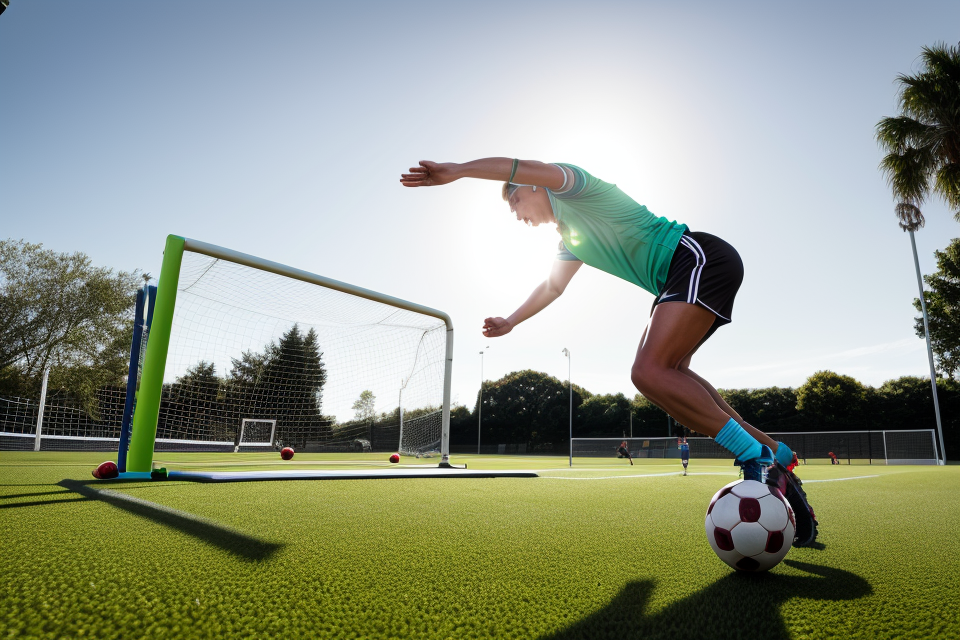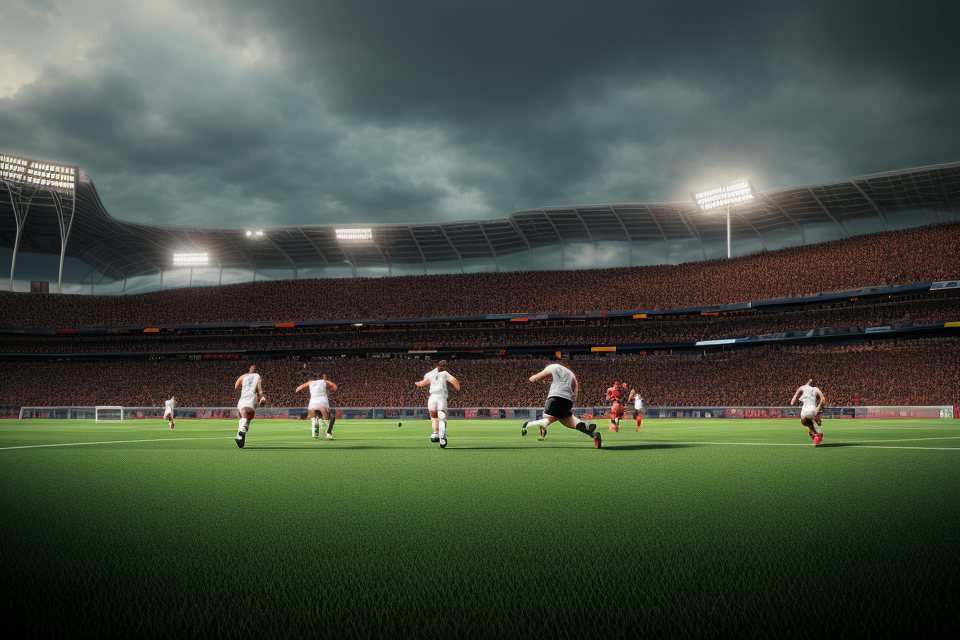Are you eager to step onto the soccer field but unsure if you’re up to the task? Determining your fitness level for soccer is essential to ensuring you’re ready to take on the physical demands of the game. In this article, we’ll explore various ways to assess your fitness level and provide tips on how to improve it. From endurance and strength to agility and speed, we’ll cover it all. So, if you’re ready to take your soccer game to the next level, keep reading to discover how to assess your fitness level for soccer.
To assess your fitness level for soccer, you can start by performing a self-assessment that includes evaluating your endurance, strength, speed, and agility. This can be done by completing a beep test, which measures your aerobic capacity, or by performing exercises such as sit-ups, push-ups, and squats to test your muscular strength and endurance. Additionally, you can also perform specific soccer-related drills such as dribbling, passing, and shooting to assess your technical skills and ability to perform under pressure. It’s also important to consider any previous injuries and to consult with a medical professional before starting any new exercise program.
Understanding Soccer Fitness
Physical demands of soccer
Soccer is a sport that requires a high level of physical fitness. Players need to be able to run, jump, change direction quickly, maintain endurance, and possess strength, agility, and coordination. Let’s take a closer look at each of these physical demands.
Running
Running is a fundamental aspect of soccer. Players need to be able to run long distances, sprint short distances, and change speed frequently. A good soccer player should be able to run for 90 minutes without getting tired. The distance covered during a match can vary greatly, with some players covering up to 12 miles in a single game.
Jumping
Jumping is also an important aspect of soccer. Players need to be able to jump high to head the ball, challenge for the ball in the air, and make tackles. Additionally, players need to be able to change direction quickly after jumping.
Change of direction
Change of direction is crucial in soccer. Players need to be able to move quickly and change direction without losing speed. This is especially important for midfielders and wingers who need to be able to make quick turns and change direction to evade opponents.
Endurance
Endurance is a key aspect of soccer fitness. Players need to be able to maintain a high level of intensity for the entire match. Endurance training should include both interval training and long-distance running.
Strength
Strength is also important in soccer. Players need to be able to control the ball, make tackles, and shoot accurately. Additionally, players need to be able to withstand physical challenges from opponents.
Agility
Agility is another important aspect of soccer fitness. Players need to be able to change direction quickly and make sharp turns. Agility training should include exercises such as cone drills, ladder drills, and plyometrics.
Coordination
Coordination is also crucial in soccer. Players need to be able to coordinate their movements to make successful tackles, interceptions, and passes. Coordination training should include exercises such as balance exercises and reaction drills.
In conclusion, assessing your fitness level for soccer requires an understanding of the physical demands of the sport. To be a successful soccer player, you need to be able to run, jump, change direction quickly, maintain endurance, possess strength, agility, and coordination. By assessing your fitness level in these areas, you can identify your strengths and weaknesses and develop a training program that will help you improve your overall soccer fitness.
Importance of fitness for soccer performance
- Improved speed and endurance: Soccer is a sport that requires a high level of endurance and speed. Fitness training can help players to improve their speed and endurance, allowing them to move quickly and efficiently across the field.
- Reduced risk of injury: Injuries are a common occurrence in soccer, but a fit player is less likely to suffer from injuries. Fitness training helps to improve the overall strength and flexibility of the body, reducing the risk of muscle strains and other injuries.
- Increased ability to handle physical demands of the game: Soccer is a physically demanding sport that requires players to be in top physical condition. Fitness training helps to improve the player’s ability to handle the physical demands of the game, including running, jumping, and changing direction quickly.
- Better overall athleticism: Fitness training helps to improve a player’s overall athleticism, including their strength, power, and agility. This can help players to perform better in all aspects of the game, from passing and dribbling to shooting and defending. Additionally, a higher level of fitness can also help players to recover more quickly from intense training sessions and games, allowing them to perform at their best more consistently.
Assessing Your Current Fitness Level
Self-assessment
Factors to Consider
Before conducting a self-assessment, it is important to consider several factors that can affect your fitness level. These factors include:
- Age: As you age, your fitness level may decline due to age-related changes in the body.
- Fitness goals: Your fitness level may vary depending on your specific soccer-related goals. For example, a player aiming to compete at a high level may have different fitness requirements than a player who simply enjoys playing for leisure.
- Previous injuries: If you have suffered from previous injuries, it may affect your current fitness level.
Self-Assessment Questions
To conduct a self-assessment, ask yourself the following questions:
- Do I feel physically prepared for soccer?
- How do I feel during and after a soccer game or training session?
- Am I able to perform all the physical tasks required in soccer?
- Do I have any physical limitations that may affect my performance on the field?
Rating Your Current Fitness Level
After answering these questions, rate your current fitness level on a scale of 1-10, with 1 being the lowest and 10 being the highest. Consider the following factors when determining your rating:
- Cardiovascular endurance: How well can you perform high-intensity activities, such as sprinting and jumping, without getting winded?
- Muscular strength and endurance: How strong are your muscles and how well can you maintain your strength throughout a game or training session?
- Flexibility and mobility: How flexible are you and how well can you move in different directions on the field?
- Speed and agility: How quickly can you move and change direction on the field?
By conducting a self-assessment and rating your current fitness level, you can gain a better understanding of your physical abilities and identify areas where you may need to improve in order to achieve your soccer-related goals.
Tests to measure fitness for soccer
There are several tests that can be used to assess one’s fitness level for soccer. These tests are designed to measure different aspects of fitness, such as endurance, speed, and agility. Here are some of the most commonly used tests:
Beep test
The beep test is a well-known fitness test that is often used to assess the aerobic fitness of soccer players. The test involves running between two lines, which are spaced 20 meters apart, in response to a series of beeps. The beeps get progressively faster, and the test continues until the player fails to reach the lines before the beep sounds. The test is timed, and the results are used to determine the player’s fitness level.
Yo-Yo intermittent recovery test
The Yo-Yo intermittent recovery test is another popular test that is used to assess the aerobic fitness of soccer players. The test involves running back and forth between two lines, which are spaced 20 meters apart, as quickly as possible. The player must reach the lines before the beep sounds, and the test continues for a set period of time. The test is timed, and the results are used to determine the player’s fitness level.
30-15 intermittent fitness test
The 30-15 intermittent fitness test is a test that is specifically designed to assess the fitness levels of soccer players. The test involves running back and forth between two lines, which are spaced 30 meters apart, as quickly as possible. The player must reach the lines before the beep sounds, and the test continues for a set period of time. The test is timed, and the results are used to determine the player’s fitness level.
Sprint drills
Sprint drills are used to assess the speed and power of soccer players. These drills involve running as fast as possible over a set distance, such as 10, 20, or 30 meters. The drills are timed, and the results are used to determine the player’s speed and power.
Agility drills
Agility drills are used to assess the ability of soccer players to change direction quickly and efficiently. These drills involve moving in different directions, such as left, right, forward, and backward, as quickly as possible. The drills are timed, and the results are used to determine the player’s agility.
Developing a Fitness Training Program
Setting goals
Assessing your fitness level for soccer is the first step in developing a training program that will help you achieve your goals. To effectively train for soccer, it is important to set specific, measurable, achievable, relevant, and time-bound (SMART) goals.
- Improve endurance: One of the most important aspects of soccer is endurance. Endurance is the ability to maintain a high level of physical activity for an extended period of time. To improve your endurance, you should aim to increase the duration and intensity of your training sessions.
- Increase speed and agility: Speed and agility are crucial for success in soccer. To improve your speed and agility, you should incorporate exercises that focus on quick movements, such as plyometrics and interval training.
- Develop strength and power: Soccer requires a combination of strength and power. To develop these attributes, you should include exercises that target the muscles used in soccer, such as squats, lunges, and deadlifts.
- Prevent injuries: Injuries are a common occurrence in soccer, but they can be prevented with proper training. To prevent injuries, you should focus on strengthening areas prone to injury, such as the knees and ankles, and incorporate exercises that improve flexibility and mobility.
By setting specific goals, you can create a training program that is tailored to your individual needs and will help you become a better soccer player.
Creating a training plan
Assessing your fitness level for soccer is crucial in determining your readiness to take on the physical demands of the sport. Developing a comprehensive training program tailored to your individual needs and goals is essential in improving your overall fitness level.
To create an effective training plan, it is recommended to consult with a coach or fitness professional who specializes in soccer-specific training. They can help assess your current fitness level, identify areas of improvement, and design a training program that meets your specific needs.
A well-rounded training plan should include a variety of exercises that target different aspects of fitness, such as strength, endurance, and power. Some exercises that may be included in a soccer-specific training program include:
- Strength and conditioning exercises: These exercises aim to improve muscular strength and endurance, which are important for maintaining peak physical performance during matches. Examples of strength and conditioning exercises include weightlifting, resistance training, and bodyweight exercises such as push-ups and squats.
- Plyometrics: Plyometric exercises involve explosive movements that help develop power and speed, which are essential for quick acceleration and change of direction on the field. Examples of plyometric exercises include box jumps, bounds, and agility drills.
- Interval training: Interval training involves alternating periods of high-intensity exercise with periods of rest or low-intensity exercise. This type of training is effective for improving cardiovascular endurance and can be incorporated into soccer-specific drills such as shuttle runs and sprint intervals.
It is important to gradually increase the intensity of your training program over time to avoid injury and allow your body to adapt to the demands of the sport. A well-designed training plan should also include adequate rest and recovery time to allow muscles to repair and rebuild, which is crucial for optimal performance and injury prevention.
Incorporating soccer-specific drills
Soccer-specific drills are essential for developing the physical attributes necessary for success on the soccer field. These drills are designed to simulate game-like scenarios, which helps to improve the player’s ability to perform under pressure. Here are some examples of soccer-specific drills that can be incorporated into a fitness training program:
- Passing drills: Passing is a crucial aspect of soccer, and passing drills can help to improve accuracy, distance, and technique. For example, players can practice short and long passes, as well as crossing and switching the ball from one foot to the other.
- Dribbling drills: Dribbling is another important aspect of soccer, and dribbling drills can help to improve ball control, agility, and speed. For example, players can practice moving the ball around cones, changing direction, and beating opponents.
- Shooting drills: Shooting is a key aspect of scoring goals in soccer, and shooting drills can help to improve accuracy, power, and technique. For example, players can practice shooting from different distances, angles, and situations, such as one-on-one or from set pieces.
- Small-sided games: Small-sided games are a great way to improve teamwork and decision-making skills. For example, players can practice 3v3, 4v4, or 5v5 games, which require players to work together and make quick decisions.
By incorporating these soccer-specific drills into a fitness training program, players can develop the physical attributes necessary for success on the soccer field.
Monitoring progress
To accurately assess your fitness level for soccer, it is important to monitor your progress throughout your training program. Here are some key things to keep in mind when monitoring your progress:
Keep track of improvements in speed, endurance, and agility
One of the best ways to assess your fitness level for soccer is to track your improvements in speed, endurance, and agility. This can be done by regularly performing exercises and drills that test these areas, such as sprints, interval training, and agility drills. By tracking your performance over time, you can get a sense of how your fitness level is improving and identify areas where you need to focus your training.
Use performance metrics to measure progress
In addition to tracking your improvements in speed, endurance, and agility, it is also important to use performance metrics to measure your progress. This can include things like sprint times, distance covered during interval training, and agility test scores. By regularly measuring these metrics, you can get a more objective assessment of your fitness level and track your progress over time.
Adjust training plan as needed
As you progress through your training program, it is important to adjust your plan as needed to continue challenging yourself and improving your fitness level. This may mean increasing the intensity or duration of your workouts, or adding new exercises or drills to your routine. By regularly evaluating your progress and adjusting your training plan as needed, you can ensure that you are making continuous improvements and getting the most out of your training.
Staying motivated
- Finding a workout partner: One of the most effective ways to stay motivated during your fitness journey is to find a workout partner. This can be a friend, family member, or even a fellow soccer enthusiast. Having someone to train with can keep you accountable and provide a sense of camaraderie and support. You can push each other to work harder and achieve your goals.
- Joining a soccer fitness group: Another way to stay motivated is to join a soccer fitness group. These groups often have scheduled workouts and training sessions that are specifically designed for soccer players. Being part of a group can provide a sense of community and motivation, as well as access to experienced coaches and trainers who can provide guidance and support.
- Celebrating progress and milestones: It’s important to celebrate your progress and milestones along the way. Whether it’s losing a certain amount of weight, improving your endurance, or reaching a specific fitness goal, take time to acknowledge and celebrate your achievements. This can help keep you motivated and give you a sense of accomplishment.
- Remembering why you started: Finally, it’s important to remember why you started your fitness journey in the first place. Whether it’s to improve your soccer performance, achieve a healthier lifestyle, or simply feel better about yourself, keep your original goals in mind. Reflect on your progress and remind yourself of how far you’ve come. This can help you stay motivated and focused on your long-term goals.
FAQs
1. What are the physical requirements for soccer?
To be fit for soccer, you need to have good cardiovascular endurance, muscular strength and endurance, agility, and coordination. You should also have good flexibility and mobility, particularly in your legs and core. Additionally, you should be able to maintain your energy levels throughout the game and recover quickly from injuries or exhaustion.
2. How can I measure my fitness level for soccer?
One way to measure your fitness level for soccer is to perform a fitness test that assesses your cardiovascular endurance, muscular strength and endurance, and agility. For example, you could perform a shuttle run test, which involves running back and forth between two points and measuring your time and distance. Another option is to perform a beep test, which involves running between two lines in response to an audio signal and measuring your progress. You can also perform a Yo-Yo intermittent recovery test (IRT) which is a specific test for soccer players, it consists of a continuous run with intermittent sprints and recovery periods.
3. What should I do if I’m not meeting the physical requirements for soccer?
If you’re not meeting the physical requirements for soccer, there are several things you can do to improve your fitness level. First, you should create a training program that focuses on the specific areas where you need improvement. This could include interval training, strength training, and plyometrics. Additionally, you should make sure you’re eating a balanced diet and getting enough rest and recovery time. Finally, you should consider working with a personal trainer or a sports coach who can help you create a tailored training program and provide guidance and support.
4. How often should I train to maintain my fitness level for soccer?
To maintain your fitness level for soccer, you should aim to train at least three to four times per week. This could include a combination of endurance training, strength training, and technical drills specific to soccer. Additionally, you should make sure you’re incorporating rest and recovery days into your training schedule to allow your body to adapt and improve.
5. Can I still play soccer if I’m not the most physically fit player on the field?
Yes, you can still play soccer even if you’re not the most physically fit player on the field. Soccer is a team sport, and there are many other factors that contribute to success on the field, such as tactics, strategy, and teamwork. Additionally, even if you’re not the most physically fit player, you can still make a valuable contribution to your team by playing to your strengths and providing support to your teammates. Remember that soccer is a sport that requires a combination of physical and mental abilities, so don’t be discouraged if you don’t meet all the physical requirements right away. With consistent training and dedication, you can improve your fitness level and become a valuable member of your team.



